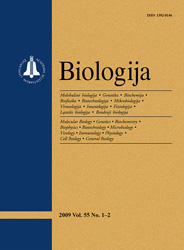 ISSN 1392-0146 ISSN 2029-0578 (online) |
2008 m. Nr. 2 Ribes sanguineum Pursh. as donor of leaf fungal disease resistance in blackcurrant breeding
Breeding of blackcurrants resistant to leaf fungal diseases there was carried out by intersectional crossing. R. nigrum (Eucoreosma) cultivars were crossed with R. sanguineum (Calobotria). In the interspecific crossing combinations within blackcurrant cultivars and clones, the berry set fluctuated from 14.3 to 62.7%. Cultivars that were linked to apomixes started more germs, but during the first weeks more of them fell down. In all the combinations of interspecific crossings there was a small amount (3.8–8.2) of seeds in berry. Among the interspecific hybrids, the amount of plants resistant to powdery mildew (Sphaerotheca mors-uvae), Septoria leaf spot (Mycosphaerella ribis) and anthracnose (Pseudopeziza ribis) increased significantly. Interspecific R. nigrum × R. sanguineum F1–F2 hybrids most often distinguished themselves by a larger number of berries per cluster in comparison with blackcurrants. Berries were of medium size equal to that in blackcurrant cultivars of standard assortment. Berries of the interspecific hybrids had less seeds. There was no dependence between seed number and berry size. Keywords: R. nigrum, R. sanguineum, interspecific hybridization, fungal diseases |
Issues:
2011 - Vol.57 No. 1, No. 2, No. 3 2010 - Vol.56 No. 1-4 2009 - Vol.55 No. 1-2, No. 3-4 2008 - Vol.54 No. 1, No. 2, No. 3, No. 4 2007 - Vol.53 No. 1, No. 2, No. 3, No. 4 2006 No. 1, No. 2, No. 3, No. 4 2005 No. 1, No. 2, No. 3, No. 4 2004 No. 1, No. 2, No. 3, No. 4 2003 No. 1, No. 2, No. 3, No. 4 2002 No. 1, No. 2, No. 3, No. 4 2001 No. 1, No. 2, No. 3, No. 4 |